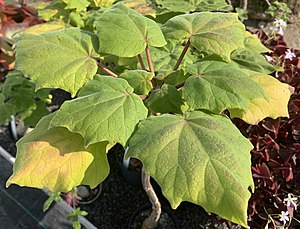Uncarina ihlenfeldtiana
| Uncarina ihlenfeldtiana | ||||||||||||
|---|---|---|---|---|---|---|---|---|---|---|---|---|

Uncarina ihlenfeldtiana |
||||||||||||
| Systematics | ||||||||||||
|
||||||||||||
| Scientific name | ||||||||||||
| Uncarina ihlenfeldtiana | ||||||||||||
| Lavranos |
Uncarina ihlenfeldtiana is a species of plant of the genus Uncarina in the sesame family (Pedaliaceae). The specific epithet ihlenfeldtiana honors the German botanist Hans-Dieter Ihlenfeldt .
description
Uncarina ihlenfeldtiana grows as a small, little branched shrub and can reach a height of 3 meters. The 5 centimeter wide and long leaf blade, which can also grow larger in culture, is undivided and has 5 tips. Intermediate lobes can also be formed. There are distinct hydathodes at the tips of the large tips . There is a pronounced color difference between the top and bottom of the leaf. The underside appears light green due to the thick trim with simple hair. A lot of mucous hairs are formed on the underside, which are regularly distributed over the surface.
The yellow flowers have a brown-red colored throat. The corolla tube is only slightly curved below the border, so that the border on older flowers is almost vertical.
The only slightly woody and laterally flattened fruit is about 5 centimeters long and 4.5 centimeters wide. The fruiting body without thorns is about 2 by 2 centimeters and has a narrow, triangular beak 1.5 centimeters long. Two different spine shapes are formed. The hook spines are up to 12 to 15 millimeters long and 6 to 7 pieces are each in 8 longitudinal rows. They are widened at the base and are therefore somewhat stiffer. The simple spines are also in longitudinal rows.
The obovate seeds do not form a gap on the side wings.
Distribution and systematics
Uncarina ihlenfeldtiana is endemic in northern Madagascar , in the Sofia region , at altitudes of 800 to 950 meters on crystalline rock.
In the first description of Uncarina sakalava , Jean-Henri Humbert already had doubts about the assignment of a paratype (Perrier de la Bâthie 15083) to this species. These doubts became apparent with the occurrence on crystalline rock (in contrast to limestone in U. sakalava ) and due to the hairiness of the leaves on other herbarium sheets . Between 1995 and 1997, the Zurich succulent collectors Walter Röösli and Ralph Hoffmann collected, among other things, a species of Uncarina near the town of Mandritsara , not far from where the Perrier plants were found. After examining the material, it turned out that this is apparently identical to Perrier's paratype. From as yet unpublished molecular data by Dr. Reto Nyffeler shows that the plants from Röösli and Hoffmann differ significantly from U. sakalava and are not closely related to this species. These plants were first described in 2004 by John Jacob Lavranos as Uncarina ihlenfeldtiana .
literature
- John J. Lavranos In: Schumannia 4: Succulent research in Africa. Succulent Plant Research in Africa , "Uncarina ihlenfeldtiana (Pedaliaceae) A new species from the northern highlands of Madagascar", pp. 83–86, 2004
Web links
- Information from GBIF on Art
